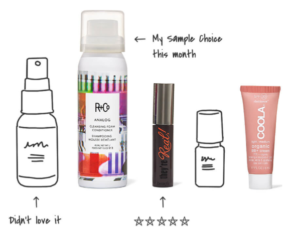While I first learned of Birch Box a while ago, I would like to take the time in this post to highlight the shear genius of box subscription services like this one. There are two features of this service that I would like to touch on: the upsell possibility and the data possibility.
First, let’s start with the upsell possibility. Birchbox is a subscription beauty supply sample box. The consumer chooses a subscription type from monthly (no engagement), 6-month and 12-month subscription and pays a monthly fee between $7 and $10 per month. Then, the consumer is shipped five samples per month in their box. This is great on three levels: (1) the consumer is paying to get samples, which aids the marketing budget of those companies; (2) the consumers who sign up for this program are open to the idea of being hooked on a new product, so the conversion rate is likely to be higher than the average sample conversion rate; and (3) consumers willingly expose themselves to different products that they are likely to get hooked on, so they are taking a lot of the effort out of having to upsell them on make-up.
 Now, let’s consider the data possibility. Traditionally, consumers would go to the store and purchase the beauty product that they are looking for and would go home. All that the company has received from that is transactional data. The only indication of whether or not a consumer liked the product is whether or not they bought the product again at a later time. Reviews are also indications of whether or not a consumer liked the product but those reviews cannot be tied back to a specific consumer, which detracts for the data analysis potential. Plus, consumers would only post a review if they had any extreme feelings towards the product which does not allow for representative data. With this subscription box, data analysts have a lot more access to individual buying patterns. First, consumers can rate and review the samples that they receive. This gives insight into which type of consumers like which type of products. Additionally, they have the possibility of choosing one of their five samples every month. This gives insight into which types of products consumers are drawn to without being prompted or encouraged to try them. Finally, once they have tried the products, analysts can look at which products the consumer bought. This is different from the rating because in addition to attitude toward the product, it includes a drive to action. The genius of this whole subscription model is that the consumer is constantly linked to their account when they are taking these steps. As a result, all of these attitudes can be linked to a specific identifier and can then be used to create customer profiles.
Now, let’s consider the data possibility. Traditionally, consumers would go to the store and purchase the beauty product that they are looking for and would go home. All that the company has received from that is transactional data. The only indication of whether or not a consumer liked the product is whether or not they bought the product again at a later time. Reviews are also indications of whether or not a consumer liked the product but those reviews cannot be tied back to a specific consumer, which detracts for the data analysis potential. Plus, consumers would only post a review if they had any extreme feelings towards the product which does not allow for representative data. With this subscription box, data analysts have a lot more access to individual buying patterns. First, consumers can rate and review the samples that they receive. This gives insight into which type of consumers like which type of products. Additionally, they have the possibility of choosing one of their five samples every month. This gives insight into which types of products consumers are drawn to without being prompted or encouraged to try them. Finally, once they have tried the products, analysts can look at which products the consumer bought. This is different from the rating because in addition to attitude toward the product, it includes a drive to action. The genius of this whole subscription model is that the consumer is constantly linked to their account when they are taking these steps. As a result, all of these attitudes can be linked to a specific identifier and can then be used to create customer profiles.
One of the limitations of this program is that it allows consumers to try the products before they opt for the full size of the product. In this way, consumers who might have bought the full size to try a product that they are interested in might not do so after experiencing the sample. Do you see any other benefits or drawbacks of this subscription model?